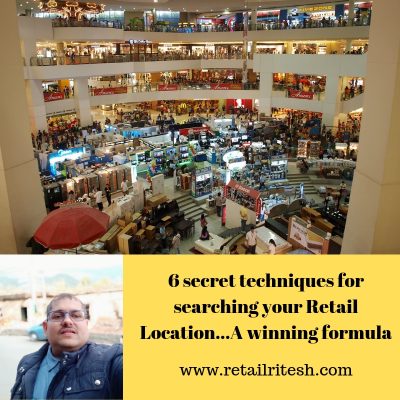6 secret techniques for searching your Retail Location- A winning formula
The most important winning formula for retail business is Location, Location, and Location.
Yet, most of the time, failure lies in this location aspect for any retail business. Retailers, often tend to forget the basics of location selection.
This article is an attempt to help upcoming retailers and existing retailers to fine-tune their retail location checklists or to make a new checklist, in case they don’t have one yet.
1.Pre-checklist for a retail location.
a) Define & classify your product type
Are you selling specialty goods, convenience goods, fashion, high ticket items, etc? Your answers will define your location requirements.
b) Determine how much retail space, storage area, or the size of the shop you need?
2. Demographics & Area profiling for a retail location.
Use the economic data to find out the population living in your proposed retail location catchment area. Are they your target customers? What is their household incomes?
Another way to look at this is from your customer’s point of view.
Where would your customers prefer you to be located?
If you’re a doctor or lawyer, would customers prefer a central location near a hospital or the courthouse?
If you are a coffee shop, wouldn’t you attract office goers if you opt for a location in office districts?
Put yourself in your buyer’s shoes.
learn about franchising, read here
3. Accessibility, Visibility & Footfalls.

Look for a location that’s easy to see and find, with plenty of customer parking in the front. Consider the convenience of vendors in delivering inventory. For example, if you’re opening a hypermarket concept, you need enough space for your delivery trucks for deliveries and the area should be accessible to families for moving trolleys and dedicated parking lots, etc.
Visibility is of the core essence. A good retail location is worth millions of online impressions or front page insertions in popular newspapers. Analyze the visibility from the number of people who pass through it, seeing your visible signage and branding.
Concepts like ultra niche luxury, high ticket items prefer to have their own zoning inside the mall to maintain privacy and high brand imagery as they want only potential customers to visit their zone.
4. Brand adjacencies – Make or break factor.
It is important for brands to know with whom they are hanging around. Are their neighboring brands are complimenting or competing businesses.
If you want to sell high-end women’s apparel, locating near other upscale women’s apparel, make-up salon or a jewelry stores is a plus, because apparel shoppers visit several stores and these stores attract a similar target audience i.e. fashion-conscious customers.
Alternatively, an office supplies store wouldn’t want a similar store down the street. Locations near restaurants or entertainment venues, or even a big-box store, can benefit your store if those businesses attract your target customer base.
learn about a boom in men’s grooming market, read here.
5. Understand your retail location lease before signing.
Analyze the deliverables offered in your lease agreement. Check the no. of parking lots allocated to your brand (in case you are an anchor tenant and need dedicated parking spaces). Look for the facilities and common area charges that have been quoted in your lease agreement. These are the main factors that inflate your rentals. Look out for marketing fees, higher fees would make your P&L unfeasible.
But if you’re looking to launch a new business in a retail space, don’t let the lure of low rent tempt you into a lease deal. This can kill your business before it ever gets off the ground.
And don’t let a higher lease or rent payment scare you. If a location offers prime foot-traffic, walk-ins and easy access for your customers, it may be well worth the investment. In this context, your lease is simply part of your marketing spending to get people inside your store.
6. Compliance with local laws and authorities
Follow the local regulations and restrictions, check out on the employee’s recruitment criteria’s, there are certain regulations stating employment for certain nationalities/ locals, etc.
Check out the working hours for the shopping centers since longer duration means more manpower for your shop operations which might hamper your store P&L.
Conclusion:
These 6 techniques or checklist would ensure that you are in alignment with your retail objectives. This would result in a profitable store location. My readers in case of any location help or need may feel free to write to me on riteshmohan@yahoo.com.
About the author:
Ritesh Mohan is a passionate retail professional with over 20 years in the Retail sector, handling some of the biggest brands in beauty, fashion and fragrances retail & FMCG sector. He has been instrumental in the growth of some of the regional brands as well in the Middle East region. Ritesh specializes in Retail management, Product development, and Brand Management, Retail Operations, Sales Management, and Franchising & Business Management. He believes in empowering business owners with his wisdom & experience of around two decades in the industry.

